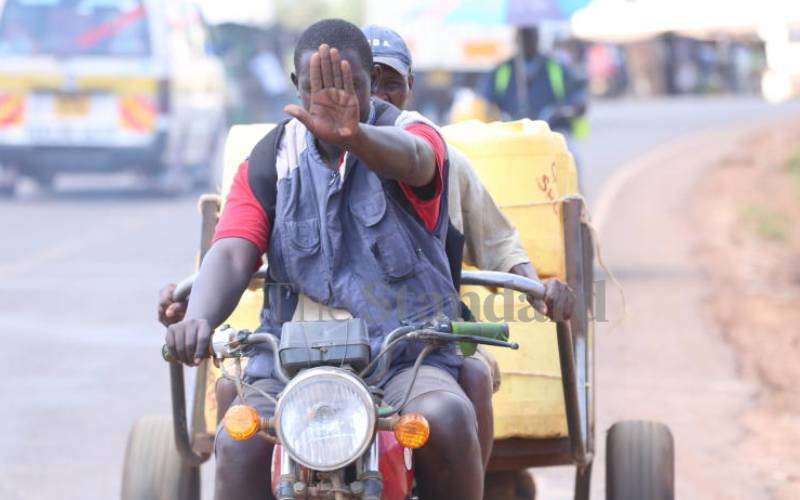By Wachira Kigotho
Even though remarkable progress has been made in the last ten years in enrolling children in school, 32 million children are out of school in Sub-Saharan Africa, says a report.
The Unesco 2010 Education for All Global Monitoring report says this represents 45 per cent of the global primary school age children out of school.
The report further says that 21 million adolescents, representing about 40 per cent of the lower secondary school age group, are out of school. It adds that millions of children in the region are leaving school without acquiring basic skills.
Hendrik van der Pol, the Director of Unesco’s Institute of Statistics, says in many countries in Sub-Saharan Africa, adolescents with five years of education have a 40 per cent probability of being illiterate.
"On average, at 7.6 years, Sub-Saharan Africa has one of the lowest school life expectancy globally," says Hendrik.
School life expectancy is the number of years a child of school entrance age can expect to spend in school.
Currently, school life expectancy rate in Kenya, Tanzania and Uganda stands at 7.5 years, compared to six years in West and Central African countries.
"No country has achieved or is close to attain some of the easily quantifiable education for all goals," says the report.
Disadvantaged
Using new data set on education marginalisation in Sub-Saharan Africa, researchers noted there is a web of interaction between factors that enhance exclusion in education.
"Poverty and gender intersect with language, ethnicity, region and rural-urban differences to create mutually reinforcing disadvantages," says Mr Kevin Watkins, head of Unesco’s 2010 Education for All 2010 Global Monitoring Report team.
For instance in North-Eastern Province and other pastoral districts in Kenya, enrolment stands at about 40 per cent, several years after free primary education was introduced. "It is not just a matter of abolition of school fees, but being a nomad increases the risk of being out of school, not only in Kenya but also elsewhere in Sub-Saharan Africa," says Watkins.
And in Nigeria, where on average a child spends about 6.5 years in school, a poor rural girl’s school life expectancy is less than six months. Similarly in Chad, where conflict has led to large-scale displacement, more than 90 per cent of children have less than four years of education.
Commenting further on Kenya’s education system, the report says gains of the free primary education are likely to be lost by lack of sufficient funds, health risks, inefficiency and corruption, among other factors. Parental wealth influences prospects of a child being in school.
Poor families
In Kenya, 20 per cent of children from poor families — comprising children from urban slums, poor rural and pastoral communities —are out of school.
The report reminds Kenyans that getting children into school through abolition of fees is just one of the stepping stones towards universal primary education. "Many children are likely to drop out before completing the primary cycle," says the report.
High enrolment rate immediately after abolition of school fees has masked a complex picture with districts moving in different directions.
"In some districts enrolment has stagnated and even children dropping out of school, while enrolment momentum is maintained in high potential districts and urban areas," says the report.
According to Watkins, economic downturn between 2003 and 2008 as well as drought resulted into high food prices forcing many poor households to cut on schooling.
But amid efforts to show that they are on track towards meeting goals for education for all, some countries over estimate enrolment by a considerable margin.
Attendance rate
According to the report, the discrepancy was recently noted by Unesco Institute for Statistics
Analysis of the data showed school registers had more children within the official primary school age range than the attendance rate from administrative household surveys," says the report.
However, correcting the discrepancy bias would have the effect of reducing the net enrolment ratio by significant margins in some countries.
Yet the problem does not end there. Whereas the focus is on out-of-school children of primary school age, out there, there are millions of adolescents in the lower secondary school age group out of school. The figure includes teenagers who have not completed primary school or could not be admitted to join high school after KCPE.
"Cost, distance to school, labour market demands and deeply entrenched social, cultural and economic barriers, prevent poor adolescents staying in school," says Unesco.
According to Mr Wycliffe Otieno, a lecturer at Kenyatta University, households in Kenya shoulder 60 per cent of secondary school costs compared to 20 per cent for primary.
For now the momentum of getting children into school is likely to falter, taking into account misappropriation of funds meant for basic education.
 The Standard Group Plc is a multi-media organization with investments in media
platforms spanning newspaper print operations, television, radio broadcasting,
digital and online services. The Standard Group is recognized as a leading
multi-media house in Kenya with a key influence in matters of national and
international interest.
The Standard Group Plc is a multi-media organization with investments in media
platforms spanning newspaper print operations, television, radio broadcasting,
digital and online services. The Standard Group is recognized as a leading
multi-media house in Kenya with a key influence in matters of national and
international interest.
 The Standard Group Plc is a multi-media organization with investments in media
platforms spanning newspaper print operations, television, radio broadcasting,
digital and online services. The Standard Group is recognized as a leading
multi-media house in Kenya with a key influence in matters of national and
international interest.
The Standard Group Plc is a multi-media organization with investments in media
platforms spanning newspaper print operations, television, radio broadcasting,
digital and online services. The Standard Group is recognized as a leading
multi-media house in Kenya with a key influence in matters of national and
international interest.









